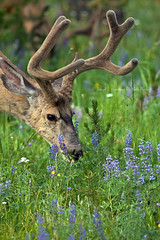 |
Clark Wheeldon and his dog Rat, hunting in the Gros Ventre Mountains.
|
Clark was my first friend in Jackson Hole; he rented me a house on his ranch and was immediately accepted into Clark's world, a world of horses, rodeo, hunting tall tales and family. It wasn’t long before my wife Sharon, and I felt as though we were a part of the family. We were soon friends with a great extended family of true western characters.
Clark always had a pot of coffee on the stove and a story to tell, and his stories were always good. A revolving door of characters were always stopping by, and he never had to worry about emptying that pot of coffee alone.
Many old cowboys are colorful characters, but Clark outshined them all. He’d start weaving the story and that twinkle would come out in his eye and that mischievous grin would cross his lips, and you knew you were in for a good one. He used to tell us about 25% of something and left the rest to our imaginations. Clark was a man of mysteries, and he would almost tell you some of them. I firmly believe all that Clark left to my imagination about deeds he hinted that he may have done.
 |
Clark and Granddaugheter Sadee Wheeldon horseback riding in the Gros Ventre Wilderness
|
Clark knew I was pretty good about keeping my dog secured and didn’t let him run abound, but one day he got through a cracked door. Spot, the dog went chasing sheep and bit up about ten of them, a week later one of them died. I promptly went over and tried to pay for the sheep.
Clark says: “ You ain’t paying for the sheep”
Me: Yes I am, my dog killed your sheep and I’m paying you for him.
This went back and forth for a bit until Clark concluded.
It ain’t your fault that sheep died, you know how those sheep are, their head gets a little bit to close to the ground then they are dead. You ain’t paying for that sheep!
 |
Clark Wheeldon, hunting client Bruce and I on hunting trip in the Gros Ventre Mountains
|
Most ranchers have a cow dog, not Clark; Clark had a dackusaund hound named Rat that rode on his horse with him. It was something to see. He had a piece of carpet tied onto the back of the saddle so Rat would have a place to ride. He did make Rat walk a lot but when it was time to ride he would tell Rat to load.
I happened to be out of town when my moving truck came, and I had hired some young movers to move the stuff into the house, Clark stopped by to find the two movers sitting on the front steps while putting off carrying my safe into the house, Sharon said Clark was pissed these workers were sitting on their ass and he went over to the moving truck, and 63 year old Clark picked up the safe and took it into the house; the embarrassed movers jumped back to work.
Our friend Harry Taylor was known to overindulge in the booze more than he should, well one day after retirement age Harry went out and got a job, all was well until he up and died. Visiting with Clark shortly thereafter we were bemoaning Harry’s demise, and Clark said, “ That’s it – I’m quitting."
Me: I asked, “ What are you quitting Clark” expecting him to reply “ Drinking”
Clark: Working, I’m gonna quit working, look what it did to Harry!
About ten years ago Clark got a hip replacement so I decided I would drop in on him and see how he was doing.
Me: It looks like you are getting around on that new hip pretty good.
Clark: Yep, pretty good, pretty good.
Knowing that what a good sense of humor Clark had I replied.
Me: Well when are the going to get around too replacing you rest of you?
Clark: Ha, ha, ha, I don’t know but it better be soon!
I knew Clark would have a clever response :D
My times on the ranch are treasured memories and one of the highlights of my life.
 |  |
 |  |
Clark wasn't a big fan of the government and I would like to share a couple of his poems he wrote on the subject


 |
Happy Trails Clark - Godspeed
If anyone has any Clark Wheeldon Stories please share them below |





 There’s only one word for skiing at Grand Targhee: extraordinary. Though other words such as effortless, knee-deep, and uncrowded all apply. The key is the more than 500 inches a year that fall on the backside of the Tetons – the snowier Western side – each year. Add to that a skiable terrain of nearly 2000 acres, with more than 1,000 reserved for Sno-Cat Adventures, and you have an experience beyond compare. In addition to Grand Targhee’s legendary powder, families love our corduroy grooming with cruising runs that are a signature of Grand Targhee Resort.
There’s only one word for skiing at Grand Targhee: extraordinary. Though other words such as effortless, knee-deep, and uncrowded all apply. The key is the more than 500 inches a year that fall on the backside of the Tetons – the snowier Western side – each year. Add to that a skiable terrain of nearly 2000 acres, with more than 1,000 reserved for Sno-Cat Adventures, and you have an experience beyond compare. In addition to Grand Targhee’s legendary powder, families love our corduroy grooming with cruising runs that are a signature of Grand Targhee Resort.


























